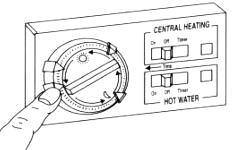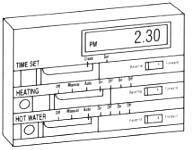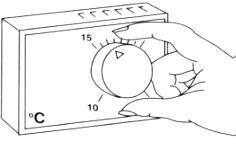How to set up your gas and electricity accounts
While your property has been empty, we have tested all the gas appliances to make sure that they are safe. We have also tested the electrical system to make sure it is safe.
Now that you are the tenant of your new home, you will need to arrange to have electricity and gas accounts put into your name.
For safety, the gas and electricity have been disconnected. This means you will not have light, heating or hot water until you have followed the steps shown below.
Step 1: Contact our customer service centre on 0800 023 4499 to arrange for our contractor to turn on the gas supply and test and demonstrate the appliances.
Step 2: Once this is done you will be able to get heating and hot water in your new home. If there are prepayment meters in the property, then you need to make sure that these have credit on them, before we can carry out our tests.
Setting your central heating controls
You may have either a timeclock or a digital programmer to control the heating and hot water on and off times.
A timeclock or digital programmer automatically turns the heating and hot water on and off at times you set.
You have three switches that control the on and off times:
- AUTO, which automatically turns the heating and hot water on and off at times that you set
- ON, which you can use to manually override the automatically set starting time
- OFF, which you can use to override the automatically set finishing time.
Set the heating to go off during the night and during the day if your home is empty.
During freezing weather, keep a low heat on all the time.
To set a timeclock programmer

Check the clock is showing the correct time. Adjust it if necessary.
Timeclock programmers have sets of pins or arrows for setting the heating programme.
Pins: push them in against any time when you want the heating to be on and pull them out against any time when you want the heating to be off.
Arrows: slide the 'on' arrows (usually red) around the clock to the times when you want the heating to come on and slide the 'off' arrows (usually blue) around to the times when you want the heating to go off.
Set the switch to 'timer' or 'auto' (depending on the unit).
Most programmers have an instruction panel to guide you.
To set a digital programmer

Check the clock is showing the correct time. If not, put the timer switch to 'clock' and adjust the time using the 'forward' and 'reverse' (+ and -) buttons.
Set the switch to each setting of 'on' and 'off' in turn and adjust the time setting.
Reset the timer switch to 'auto'.
Set the 'heating' and 'hot water' switches to come on once, twice or stay on all the time, as you prefer. Check that the settings are as you want.
Room heating

A room thermostat controls the heating to keep the room at the temperature you have set.
A comfortable temperature is usually between 18°C and 22°C.
Saving energy and energy performance certificates
When you sign your new tenancy, you will be given an Energy Performance Certificate (EPC) for your property.
EPCs are required by law when a property is built, sold or rented. It contains information about a property's energy use, typical energy costs and recommendations about how to reduce energy use and save money.
The EPC gives your property an energy efficiency rating ranging from A (most efficient) to G (least efficient) and it is valid for 10 years.
When thinking about saving energy it is helpful to know how to use your central heating system efficiently. If available, make use of the timers, thermostats and Thermostatic Radiator Valves (TRVs) in your property to adjust the system to suit your needs.
When you move in, a gas engineer will come to carry out a gas safety check. They will be able to explain to you how the system works, so please make use of this visit to get some expert advice!
Just changing a few things could help you save money!
These are changes we can all make to our daily routines, to help save money:
- turn your thermostat down 1 degree
- fill unused space in your freezer with rolled newspaper
- draw your curtains at dusk, also think about using door curtains for external doors
- switch the lights off in the rooms you don't use and use energy saving bulbs
- don't leave things on stand-by
- only fill and boil the kettle with the water you need
- use washing machines and dryers to full capacity unless you have half load settings
- don't leave taps dripping, especially hot water taps. Please call the Housing Repairs Centre on 0800 023 4499 for assistance
- close doors to keep the heat in rooms.
Household contents insurance
The council insures the building that you live in but you are responsible for insuring the contents of your home.
If there is a fire, flood or theft, we are only responsible for the structure of the building and our fixture and fittings.
The following fixtures and fittings are covered:
- built-in furniture and built-in ovens and hobs
- fixed glass and fixed sanitary ware
- pipes, ducts, tanks, cables, switches, fires, boilers and storage heaters, all of which are permanently fixed
- wall, floor and ceiling coverings which are permanently fixed are covered, other than carpets and laminate flooring (which is not allowed in flats).
You are therefore strongly advised to organise your own contents insurance to protect your belongings and to cover damage to your possessions. We do not insure your furniture, belongings or decorations against theft, fire, vandalism or burst pipes.
A comprehensive household policy also includes third party cover, which means that if someone else makes a claim against you the policy covers you for some of the cost. An example of this could be if you were to leave a tap running and water damages the flat below.
Under Part E, section 2 (i) of the Tenancy Agreement relating to your repair and maintenance responsibilities it states that:
"We will insure the structure of the building and our fixtures and fittings against loss or damage caused by certain risks. However, you are responsible for insuring your belongings in your home."